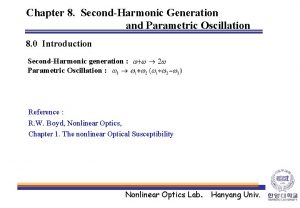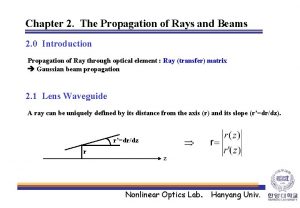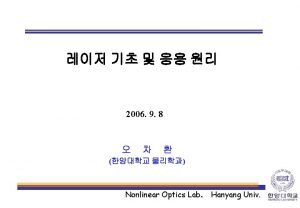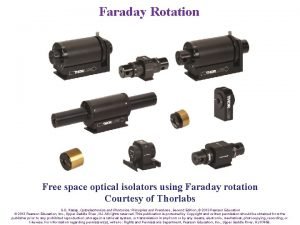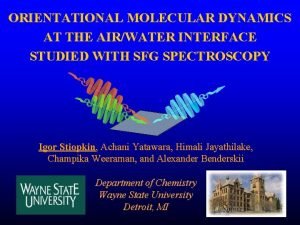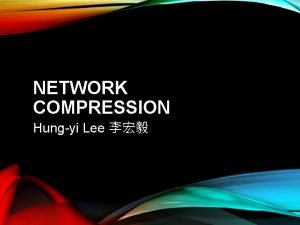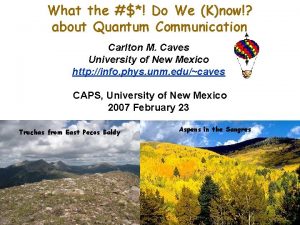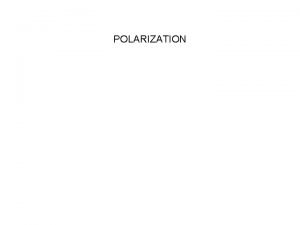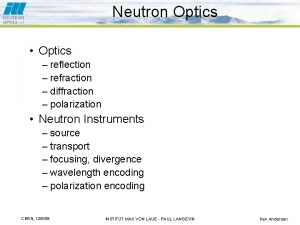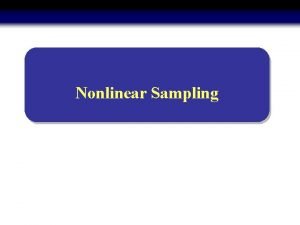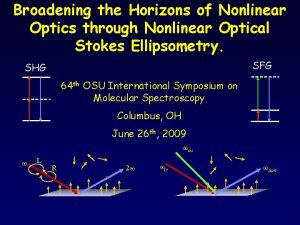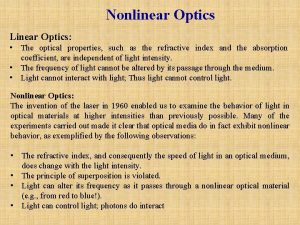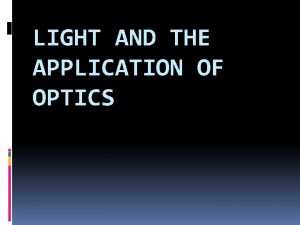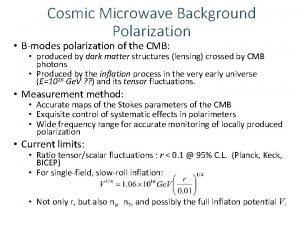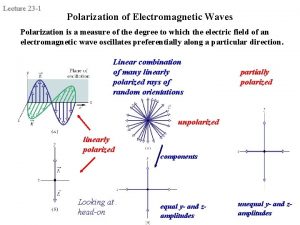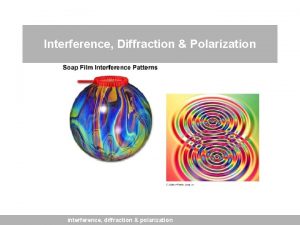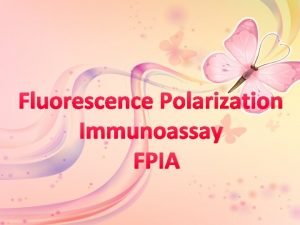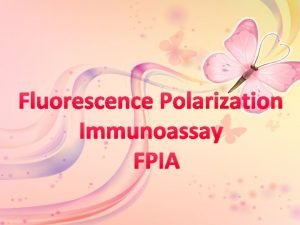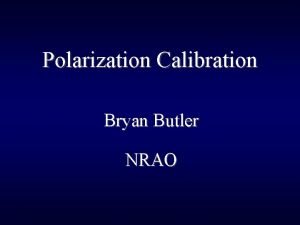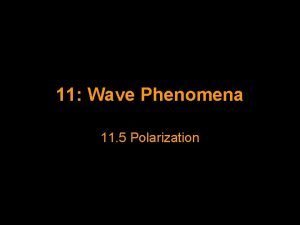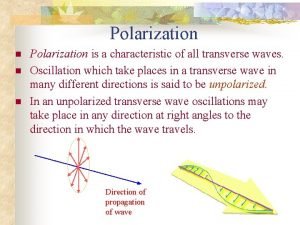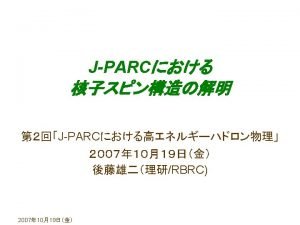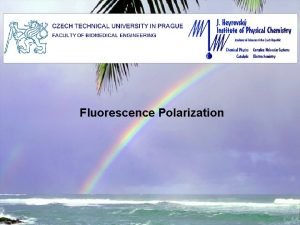Polarization in Nonlinear Optics Rethinking Old Ideas SFG























- Slides: 23

Polarization in Nonlinear Optics: Rethinking Old Ideas SFG SHG Nathan J. Begue Purdue University vis L R 2 ir sum Second harmonic generation (SHG) and sumfrequency generation (SFG) are symmetry forbidden in isotropic media but allowed at the interface 1 between two such media.

Polarization Effects in Nonlinear Optics: Chirality L R In absorbance, RCD is typically ~0. 1% to 1%. R L 2 In SHG, RCD approaches 100% Objective: Develop a predictive framework for interpreting the chiral-specific second-order nonlinear optical properties of oriented and isotropic systems. 2

Polarization analysis: The devil is in the details. 1. Intensity-based polarization analyses are generally inapplicable on resonance. But Near Resonance… n w w 2 w 0 …the complex-valued tensor element ratios often cannot be uniquely determined by comparing intensities acquired at a single angle of incidence. 3

The Goal: Routine Polarization Analysis by SHG Four major hurdles must be overcome. 1. Development of an intuitive framework for interpreting the molecular properties that drive optical activity in SHG and SFG. 2. Simplification of the relationships connecting molecular and surface nonlinearity. 3. Improvement in the instrumental methods used for polarization analysis. 4. Construction of reliable models for treating the thin film optics in SHG and SFG (i. e. , Fresnel factors). 4

Our approach: Pilfer ideas from linear ellipsometry 1. The change in polarization upon reflection or transmission at a surface is measured. Lig ht s r o t c e Det our ce Pol λ/4 2. The change in ellipticity of the incident beam is used to calculate the complex-valued elements of the Jones matrix describing reflection. 3. The measured complex ratio of the Jones matrix elements are then related back to thin film properties using a given interfacial model. 5

Nonlinear Film 1064 nm Nd: YAG Pol Waveplate rotation angle: λ/2 λ/4 a. Hw -45 o PMT #2 Nonlinear Optical Null Ellipsometry (NONE) 532 nm PMT #1 λ/4 λ/2 Pol a. Q 2 w a. H 2 w Instead of measuring intensity, measure the complete polarization state of the exigent beam. (1) Plocinik, R. M. ; Simpson, G. J. , Anal. Chim. Acta 2003, 496, 133. (2) Plocinik, R. M. ; Everly, R. M. , Simpson, G. J. , Phys. Rev. B. 2005, 72, 125409. 6

Label-free measurement of binding -SHG and SFG are very sensitive to surface orientation. BSA solution introduced B A w 2 w 7 (3) Polizzi, M. A. ; Plocinik, R. M. ; Simpson, G. J. , JACS 2004, 126, 5001.

Generalized Nonlinear Optical Ellipsometry (NOE) -null ellipsometry -rotating quarter wave plate ellipsometry -rotating half wave plate ellipsometry rhodamine labeled dextran 8 (2) Plocinik, R. M. ; Everly, R. M. , Simpson, G. J. , Phys. Rev. B. 2005, 72, 125409.

The second generation instrument: Maximum flexibility! ρL ρ -45 ρR 9 (4) Dehen, C. J. ; Simpson, G. J. in preparation.

1 W PMT 800 nm Sample Ti: Sapphire fs Laser PMT PM T Half wave plate at 22. 5 o PM 5 W 532 nm T The goal: Complete polarization analysis in less than a second! PEM Partially polarizing beam splitter Quarter wave plate at 45 o -Stokes ellipsometry approach allows complete polarization determination with every laser pulse. -A fs laser with a high (~90 MHz) repetition rate. -The incident polarization state is rapidly cycled (50 k. Hz) 10 using a photoelastic modulator (PEM).

Nonlinear Optical Stokes Ellipsometry (NOSE) 2 w Quartz Sample 100 ms 10 ms 200 ms 11

Fast Nonlinear Optical Ellipsometry 2 w Malachite Green Monolayer 1 s 12

Extracting the c(2) Jones tensors from NOSE DATA Global Least Squares Minimization ppp = 8. 84 (0. 01) + 81. 22 i (0. 02) pss = 109. 30 (0. 02) + 83. 90 i (0. 02) ssp = 52. 68 (0. 01) – 5. 36 i (0. 01) Theoretical Fits NOSE yields the full set of complex-valued c(2) tensor elements to four significant figures for total acquisition times of ~1 sec. 13 (5) Moad, A. J. ; Begue, N. J. ; Hall, V. J. ; Simpson, G. J. in preparation.

SHG and TPA Polarization Microscopy -Complete polarization analysis (including chiral information) on samples in the m. L - p. L range. w 2 w w -SHG imaging with full ellipsometric characterization at each pixel (protein identification from polarization). -Simultaneous twophoton Absorption (including polarization 14 dependence).

The Simpson Group Garth Simpson, Kyle Jacobson, Nathan Begue, Al Hilton, Ryan Plocinik, Ron Wampler, Scott Goeken Elizabeth Faust, Andy Moad, Brian Lynch, Chris Dehen, Tian Shen, John Perry, Rachel Ispas Not pictured: Victoria Hall, Nick Isaps Funding -NSF -Research Corporation (Cottrell Teacher -Scholar Award, Research Innovation Award) -Eli Lilly (Analytical Chemistry Academic Contact Committee New Faculty Award) -Sloan Foundation (Sloan Fellowship) -Beckman Foundation (Young Investigator Award) -Camille and Henry Dreyfus Foundation (New Faculty Award) -ACS-PRF Type G -Showalter Trust Organization 15

16

Generalization to Nonlinear Optical Ellipsometry 1. The complete polarization state of the nonlinear beam is measured. 2. The polarization-dependence of the exigent beam is used to calculate the complex-valued elements of a generalized Jones tensor describing the nonlinear optical process. For SHG and SFG, the Jones tensor is 2 2 2. 3. The measured complex ratios of the Jones tensor elements are then related back to the set of surface c(2) tensor elements using an interfacial model. 17

Polarization analysis: The devil is in the details. 1. Intensity-based polarization analyses are generally inapplicable on resonance. 2. The optical constants of the ultrathin interfacial layer are unknown. 3. The relationships connecting the macroscopic and molecular nonlinearity are nontrivial. 18

Step 1: What are the Key Molecular Properties Driving Optical Nonlinearity? wsum wa wb From time-dependent perturbation theory assuming a “frozen matrix”: 19 Rigorous, correct, but with few obvious chemical insights!

Just by grouping terms and performing substitutions, the complete sum-over-states expression for SFG can be rewritten identically in a more intuitive form. n w 1 wsum w 2 0 w 2 wsum n w 1 0 w 1 wsum w 2 n 0 SHG and two-photon absorption are directly linked! (1) (2) Moad, A. J. ; Simpson, G. J. J. Phys. Chem. A. 2005, 109, 1316. Moad, A. J. ; Simpson, G. J. J. Phys. Chem. B. 2004, 108, 3548. 20

Real-time measurement of unlabeled bovine serum albumin (BSA) adsorption kinetics Right circularly polarized incident beam BSA solution introduced PMT #1 532 nm λ/4 λ/2 Pol w (3) Polizzi, M. A. ; Plocinik, R. M. ; Simpson, G. J. , J. Am. Chem. Soc. , 2004, 126, 5001. 21 2 w

Real-time measurement of unlabeled bovine serum albumin (BSA) adsorption kinetics BSA solution introduced Predicted Enhancement: 26 Chiral-specific!! Ispp 2 depends exclusively on c. YXZ, providing a simple route to selectively and sensitively measure the emergence of surface chirality. Measured Enhancement: 25 4 (3) Polizzi, M. A. ; Plocinik, R. M. ; Simpson, G. J. , J. Am. Chem. Soc. , 2004, 126, 5001. 22

Because the NLO properties of the amide chromophore are dominated by interactions within a plane, macromolecular chirality can arise through an orientational mechanism analogous to that in a propeller. This chiral mechanism has no simple analog in absorbance spectroscopy, since absorption is described by a vector (within the E-dipole approx. ) rather than a tensor. Z q and y are the Euler angles describing polar tilt and planar twist, respectively. 1. 2. 3. (9) (10) (11) q x' y Chromophore Coordinates z' Macroscopic Coordinates X Y (6) Perry, J. M. ; Moad, A. J. ; Begue, N. J. ; Wampler, R. D. ; Simpson, G. J. ; J. Phys. Chem. B. 2005, 109, 20009. (7) Simpson, G. J. Chem. Phys. Chem 2004, 5, 1301. (8) Simpson, G. J. ; Moad, A. J. ; Wampler, R. D. submitted. Simpson, G. J. , Perry, J. M. ; Moad, A. J. ; Wampler, R. D. Chem. Phys. Lett. 2004, 399, 26. 23 Simpson, G. J. ; Perry, J. M. ; Ashmore-Good, C. L. Phys. Rev. B. 2002, 66, 165437. Simpson, G. . J. J. Chem. Phys. 2002, 117, 3398.
 Difference between ray optics and wave optics
Difference between ray optics and wave optics Reflection and refraction venn diagram
Reflection and refraction venn diagram Nonlinear optics
Nonlinear optics Nonlinear optics
Nonlinear optics Nonlinear optics
Nonlinear optics Nonlinear optics
Nonlinear optics Hallidays theory
Hallidays theory Sfg sfgsfg
Sfg sfgsfg Rethinking file mapping for persistent memory
Rethinking file mapping for persistent memory Kim marshall rubric
Kim marshall rubric Rethinking the 4 p's
Rethinking the 4 p's Radical redesign of business processes
Radical redesign of business processes Rethinking file mapping for persistent memory
Rethinking file mapping for persistent memory Ubígua
Ubígua Intro lll
Intro lll Rethinking the value of network pruning
Rethinking the value of network pruning Rethinking education: towards a global common good?
Rethinking education: towards a global common good? Cdio example
Cdio example Once upon a time there lived an old man and an old woman
Once upon a time there lived an old man and an old woman Once upon a time there lived an old woman
Once upon a time there lived an old woman What's your name how old are you
What's your name how old are you In the old days there lived
In the old days there lived Altruism psychology
Altruism psychology Photon polarization
Photon polarization


